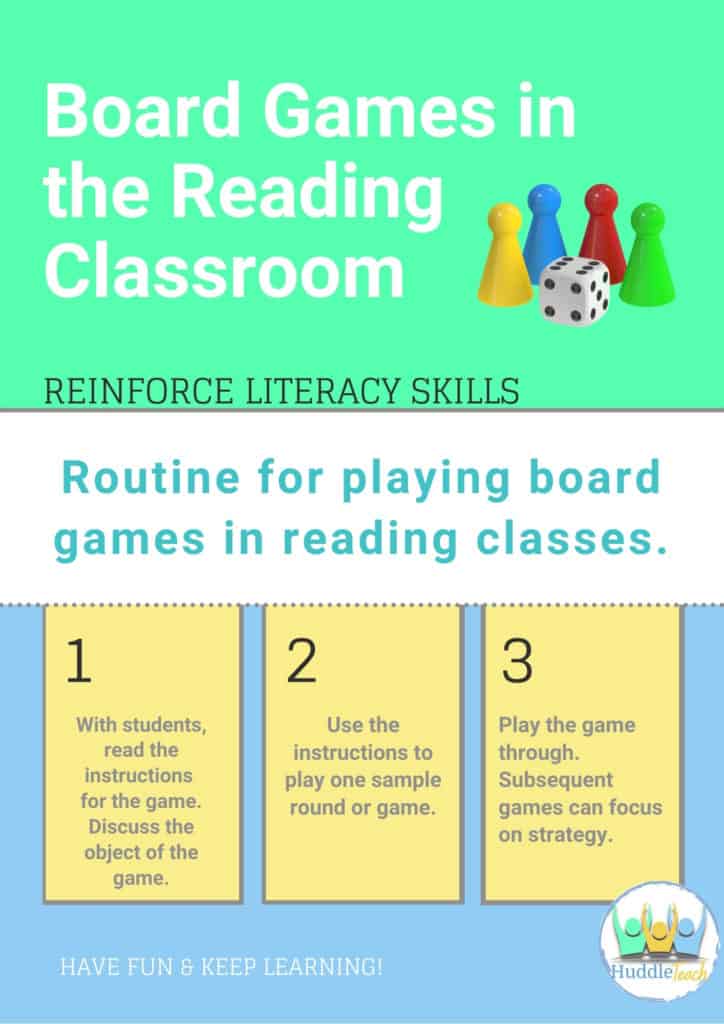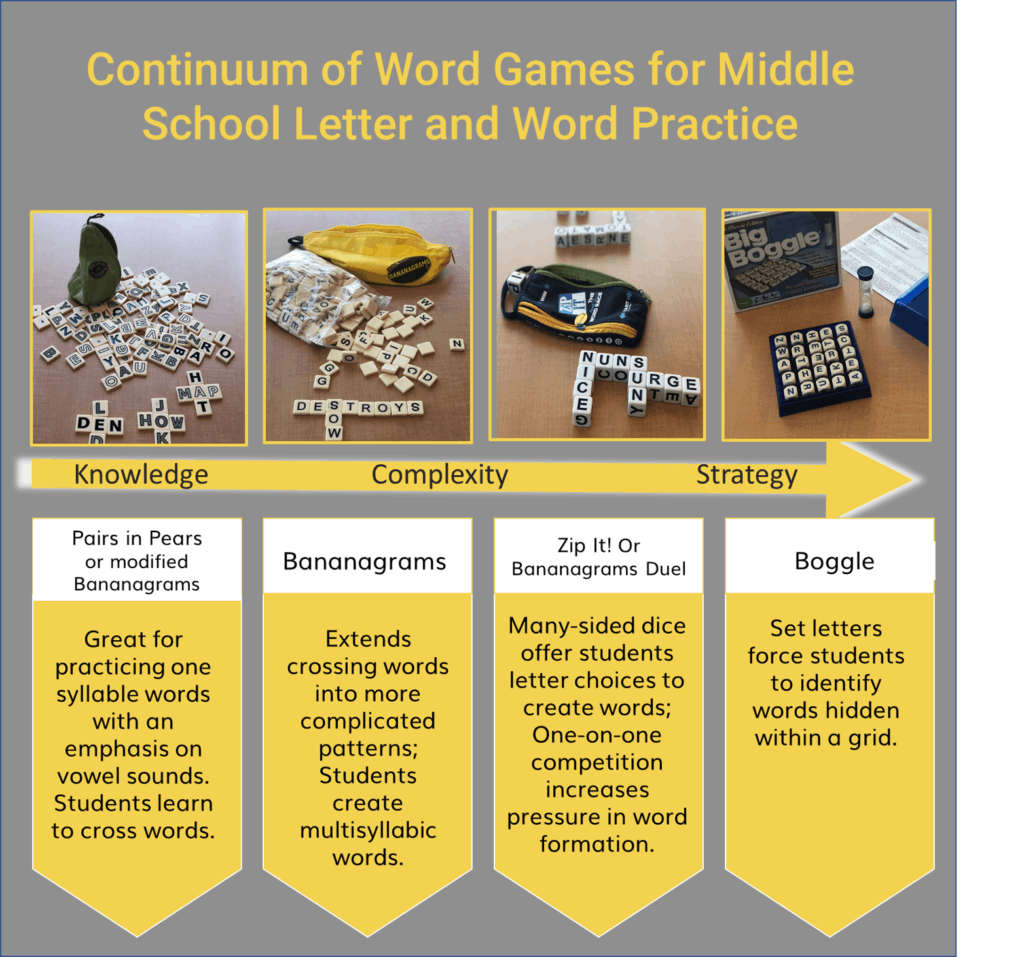No matter the topic or age, research proves that having FUN improves the engagement and learning for students. The linked article suggests such things as rooftop meetings and even visiting a ball pit! While that’s a bit extreme, finding ways to incorporate laughter and fun is necessary in a secondary reading classroom, where student buy-in is essential for progress. Setting aside a day a week (like Friday Game Day) ensures students have an opportunity to practice skills in a FUN way! Start the beginning of the year with word games that complement letter and syllable instruction, and keep the habit all year!
SO many reasons to play word games!
Games Build Community and Help Students Take Risks
When students play together over a period of time, they tend to drop bravado and shyness and open up to their peers. Only students with an outgoing personality get to that point in the first few game experiences, but there is a magical moment when students who normally do not trust their classmates laugh or joke within a game setting. Of course every class has a game personality, and that will drive social skill conversations for several games.

Playing word games with students is not a passive activity; teachers must mitigate social behavior while assisting with skills, such as spelling. And it’s not for the faint of heart – Class personalities often become apparent on the first game day! But have no fear – consistent game playing teaches students how to play nicely with each other (usually).
- The Strategic Ones: You may think these students or classes are implementing higher level thinking skills, but they are often, in fact, looking for loop holes and ways to “legally cheat” to win. Keep the rule book handy for this group!
- The Competitive Ones: These students LOVE to argue about plays and make excuses about not winning. Have patience with this group, and a bit of grace, but move quickly to the next person’s turn without spending much time validating the excuses.
- The Funny Ones: Well, it’s middle school, so watch for middle school “humor” that may be inappropriate for the setting. I often learn lots of “hip, cool” language from good-natured middle schoolers!
- The Too-Nice Ones: This sweet group of students makes any level of competition difficult. Rather than race each other in a word game, they often create The World’s Largest Crossword. If the entire class is too nice, this type of activity has its merits. If there are only a few of these students, though, they let others steal turns and take advantage. Without a few light discussions about self-advocacy, these students will be run over in a game.
Word Games Extend Learning
As part of improving learning, playing word games supports letter knowledge, spelling, and procedural text comprehension skills. Follow this routine to focus on the latter:
- Make copies of the game instructions or project them on a screen for students to see. Share read (not round robin) the important portions of the instructions. It is helpful to discuss the object of the game first, so students understand the goal of the game. Follow it up with instructions for playing and winning.
- Play a trial round of the game, referring to the instructions for clarification. Watching a video may help students understand when the game instructions are especially confusing.
- Continue playing, and as students master basic play, add in strategic moves.
The payoff for this work is playing the game, and playing it in a way that makes sense and has a purpose. (When students aren’t sure of the instructions, they tend to make them up rather than read them.)

Word games build dictionary skills!
Students with low vocabulary need the support of a dictionary – paper or electronic – as they play games. Use of one during games builds this skill naturally!
Games BRING THE FUN and learning!
But beware: Jaded students are often wary of the word GAMES.
The first time I told my middle school students that every Friday would be a game day, I received some unexpected eye rolls. The ensuing conversation went like this:
Me: What? Why eye rolls? Everyone loves a good game day!
Students: Yeah, but are these – like – games you made? Or like REAL games?
Me (realizing all those copy/colored/cut games I worked on would never cut it with this group): REAL games, of course!
Students: Like bought from the store games, or like in folders games?
Me (silently apologizing to all those teachers before me who spent DAYS making those folder games): STORE BOUGHT GAMES! I PROMISE!
Students: Well, we’ll see then.
Me: Pulling Amazon up on my phone…
Before you play a game with students:
- Play the game yourself. Figure out the nuances and determine if it is FUN!
- Reread the instructions and determine which information is the NEED TO KNOW instructions for the game. Omit extra information, such as strategy tips, versions for younger students, and bonus games.
- If the game is labeled for players over 13 years old, scan all materials for appropriateness and remove any game materials (such as cards) that are not appropriate for your student population.
- Search YouTube or game sites for videos of the game in play. Watch to be sure the video is helpful and appropriate.
The best word games for middle school students
And the order they should be played:

Pairs in Pears: This game is an introduction into crossing words and provides just the right start for syllable / vowel practice. Unfortunately, it was taken off the market within the last six months, so be on the lookout for this game in discount or resale stores. Due to the Covid-19 pandemic, I created this manipulative set that can be used to play the game with your students. (Print one set per student; have students or volunteer cut apart.) If they are not keen on teacher-made games (see above), adapt the Pairs in Pears rules to a set of Bananagram letters.
Bananagrams: This game will never go out of production, I hope! Try to find it in double or party sizes (at some retailers) for more players. The original game can be found at online retailers or through the Bananagram store.
Zip It or Bananagrams Duel: The original Zip-It has been rebranded to Bananagrams Duel, so either works for building on game play. Zip It can still be found in a few local retail stores, but Amazon also carries the newer Bananagrams Duel.
If your students are doing well with these games, Scrabble is a nice next step; however, I find that students become overwhelmed quickly and don’t always have the skills needed to make a fun game. Instead, we switch gears and move into finding words.
Boggle: Any of the Boggle family can be used as an extension of skills. This time, instead of forming words with tiles, students must think flexibly to identify words within a grid. There is a large version available, too, offering easier play for students.
After playing word games, we move into playing inferring games. More on those in a future blog!


